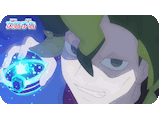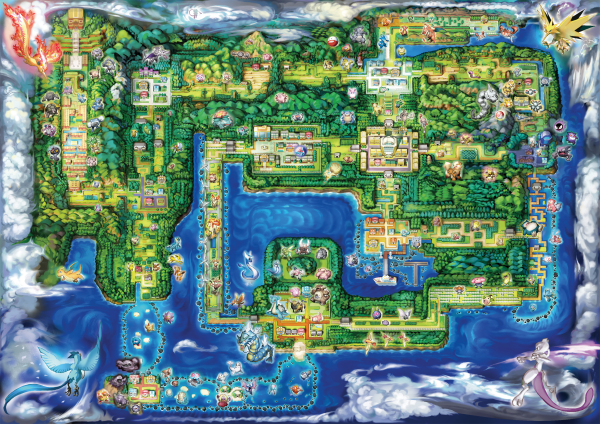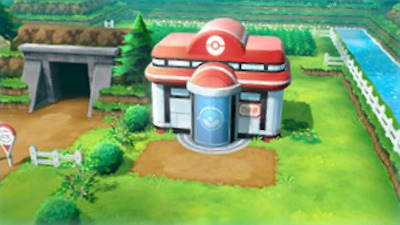



Main
Old Updates Archive
Links
 |
Lists |
List of Pokémon
Pokémon World Atlas
List of Techniques
List
of Items
List of TV Episodes
 |
Guides |
Episode
Comparisons
Movies
& Specials Guide
CD Guide
DVD Guide
Voice
Actors Guide
Lyrics Archive
Manga Guide
Video Games
 |
Miscellaneous |
Humor
Pokémon Bashing
Features
Rants
E-Mail Me
Dogasu's Backpack
| Pokemon World Atlas | The Kanto Region
The Kanto region (カントー地方) debuted in the
franchise's first generation of games, Pocket
Monsters Red & Green. It is based on the real-world Kanto
region (関東地方)
of Japan.















The Seven Islands (ナナシマ), or "Sevii Islands" as they're known in the English localizations, is an archipelago in the Southern Kanto Region. The island chain seems to be based on the Izu Islands (伊豆諸島) and the Ogasawara Islands (小笠原諸島).

Select a Region
| Kanto | Johto | Hoenn | Sinnoh | Isshu | Kalos | Alola | Galar | Paldea |
| Kanto | Johto | Hoenn | Sinnoh | Isshu | Kalos | Alola | Galar | Paldea |
| Locations - Facilities |

| Japanese Name | Name Breakdown | Notes |
English Name |
| Pokémon
Center ポケモンセンター |
Pokémon (ポケモン), short for
"Pocket Monsters" sentaa (センター), "center" |
Pokémon
Center |
|
| Friendly
Shop フレンドリィショップ |
furendori
(フレンドリィ), "friendly" shoppu (ショップ), "shop" |
Poké
Mart |
|
| Pokémon Gym ポケモンジム |
jimu (ジム), "gym" |
Pokémon
Gym |
|
| Pokémon
Day Care ポケモン育て屋 |
sodateya (育て屋), or "daycare,"
usually one run by a couple |
Pokémon
Day Care |
| Kanto Mainland |

| Japanese Name | Name Breakdown |
Real-World Model |
English Name |
| Masara
Town マサラタウン |
massara (真っ新), "brand new" masshiro (真っ白), "pure white" taun (タウン), "town" |
While
the town is often assumed to be inspired by Satoshi Tajiri's childhood
home of Machida City
(町田市), it may also be based on the Miura Peninsula
(三浦半島). |
Pallet
Town |
| Pokémon Laboratory ポケモン研究所 (ポケモンけんきゅうじょ) |
kenkyuujo (研究所), "laboratory" |
Professor
Oak's Laboratory |
|
| Route 1 1番道路 (1ばんどうろ) |
~ban (~番), "number" (as in "Route
Number 1") douro (道路), "route" |
May
be based on the Izu Peninsula
(伊豆半島) |
Route
1 |

| Japanese Name | Name Breakdown |
Real-World Model |
English Name |
| Tokiwa
City トキワシティ |
tokiwa-iro (常磐色),
a deep green color shiti (シティ), "city" |
May
be based on Mishima City
(三島市) in Shizuoka Prefecture or Hakone Town
(箱根町) in Kanagawa Prefecture |
Viridian City |
| Trainers' School トレーナーズスクール |
Pokémon
Academy |
||
| Route 2 2番道路 (2ばんどうろ) |
May
be based on Chichibu,
Satiama (埼玉県秩父市) |
Route
2 |
|
| Tokiwa
Forest トキワのもり |
tokiwa-iro (常磐色),
a deep green color mori (森), "forest" or "woods" |
Geographically
it seems to be based on the Okuchichibu
Mountains (奥秩父山塊) but the
actual forest itself seems to be based more on the Kashinokiyama
Nature
Park (かしの木山自然公園) |
Viridian Forest |
| Digda's
Hole ディグダのあな |
ana (穴), "hole" or "cave" |
May
be based on Kasori
Midden (加曽利貝塚) |
Diglett's Cave |

| Japanese Name | Name Breakdown |
Real-World Model |
English Name |
| Nibi
City ニビシティ |
nibi-iro (鈍色), a grey color | May
be based on Maebashi City (前橋市) |
Pewter
City |
| Nibi
Museum of Science ニビ科学博物館 (ニビかがくはくぶつかん) |
kagaku (科学), "science" hakubutsukan (博物館), "museum" |
May
be based on the museum formerly known as the Takao Shizen
Museum of
Science (高尾自然科学博物館). The museum is located west of where Satoshi
Tajiri
went to high school |
Pewter
Museum of Science |
| Route 3 3番道路 (3ばんどうろ) |
May
be based on the route between Kiryuu City,
Gunma (桐生市) and Ashikaga City,
Tochigi (足利市) |
Route
3 |
|
| Route 4 4番道路 (4ばんどうろ) |
May
be based on area around Sano City, Tochigi
(佐野市) and Tochigi City
(栃木市) |
Route
4 |
|
| Moon-Viewing
Mountain お つきみやま |
Otsukimi (お月見) is a Japanese
tradition where people get together and hold parties to admire the full
moon yama (山), "mountain" or "mt." |
May
be based on Mt. Akagi (赤城山).
The mountain features a crater at its
summit, not unlike the Moon-Viewing Mountain |
Mt. Moon |

| Japanese Name | Name Breakdown |
Real-World Model |
English Name |
| Hanada
City ハナダシティ |
hanada-iro (縹色), a light indigo
color |
May
be based on either Tsuchiura City
(土浦市) or Utsunomiya City
(宇都宮市) |
Cerulean
City |
| Miracle Cycle ミラクルサイクル |
mirakuru (ミラクル), "miracle" saikuru (サイクル), "(bi)cycle" |
Miracle
Cycle |
|
| Route 24 24番道路 (24ばんどうろ) |
May
be based on the area around the Nikko
National Park (日光国立公園) and Nasu Shiobara
(那須塩原) |
Route
24 |
|
| Golden Ball Bridge ゴールデンボールブリッジ |
gooruden booru (ゴールデンボール), "golden
ball," which is the English term for kindama
(金玉), the golden colored ball you get in Japanese fukibiki games burijji (ブリッジ), "bridge" |
Nugget
Bridge |
|
| Route 25 25番道路 (25ばんどうろ) |
May be based on the area around the Nikko National Park (日光国立公園) and Nasu Shiobara (那須塩原) | Route
25 |
|
| Cape Cottage 岬の小屋 (みさきのこや) |
misaki (岬), "cape" or "point of
land" koya (小屋), "cottage" |
May
be based on Kita-Ibaraki
City (北茨城市) |
Sea
Cottage |
| Hanada
Cave ハナダのどうくつ |
doukutsu (洞窟), "cave" |
May
be based on the Ashio Copper
Mine (足尾銅山) |
Cerulean Cave |
| Route 5 5番道路 (5ばんどうろ) |
May
be based on Saitama City
(さいたま市) |
Route
5 |
|
| Route 9 9番道路 (9ばんどうろ) |
May
be based on the Mito Line (水戸線),
particularly between Sakuragawa
City (桜川市) and Ishioka City
(石岡市) |
Route
9 |
|
| Route 10 10番道路 (10ばんどうろ) |
Route
10 |
||
| Rock
Mountain Tunnel イワヤマトンネル |
iwayama (岩山), "rock mountain" tonneru (トンネル), "tunnel" |
May
be based on Mt. Tsukuba
(筑波山) |
Rock Tunnel |
| Abandoned
Power Plant 無人発電所 (むじんはつでんしょ) |
mujin (無人), "abandoned,"
"deserted," or "unmanned" hatsudensho (発電所), "power plant" |
May
be based on the Tokai
Nuclear Power Plant (東海原子力発電所), which was decommissioned in 1998.
The river near the power plant may be based on Lake Kasumigaura
(霞ヶ浦) |
Power Plant |

| Japanese Name | Name Breakdown |
Real-World Model |
English Name |
| Kuchiba
City クチバシティ |
kuchiba-iro (朽葉色), a pale brown
color |
Geographically
it seems to be based on the Port of Chiba
(千葉港) but most people seem to
believe it's modeled after Yokohama City (横浜港).
The city's Gym Leader
being an American soldier may be a reference to the U.S. Navy Base in Yokosuka
(横須賀海軍施設) |
Vermillion
City |
| Kuchiba Port クチバ港 (クチバみなと) |
Vermillion
Harbor, or Vermillion Port |
||
| The "We Love Pokémon" Club ポケモンだいすきクラブ |
Pokémon
Fan Club |
||
| Route 6 6番道路 (6ばんどうろ) |
May
be based on the Keiyo Line
(京葉線) |
Route
6 |
|
| Route 11 11番道路 (11ばんどうろ) |
May
be based on the Sotobou Line
(外房線), particularly the Midori-ku (緑区) area |
Route
11 |
|
| Route 12 12番道路 (12ばんどうろ) |
May
be based on the area from Choshi City (銚子市)
to Kujuukuri
Beach (九十九里浜). Choshi City is known for being a famous fishing spot |
Route
12 |
|
| Silence Bridge サイレンズブリッジ (サイレンスブリッジ) |
sairenzu (サイレンズ) or
sairensu (サイレンス),
"silence" |
Silence
Bridge |
|
| Route 13 13番道路 (13ばんどうろ) |
May be based on the Sotobou Line (外房線), particularly the Katsu'ura City (勝浦市) area | Route 13 | |
| Route 14 14番道路 (14ばんどうろ) |
May
be based on the Sotobou Line
(外房線), particularly the Kamogawa City
(鴨川市) area. Kamogawa City is known for its wind power facilities |
Route 14 | |
| Route 15 15番道路 (15ばんどうろ) |
May be based on the Sotobou Line (外房線), particularly the Minami-Bousou City (南房総市) area | Route 15 |

| Japanese Name | Name Breakdown |
Real-World Model |
English Name |
| Shion
Town シオンタウン |
shion-iro (紫苑色), a light purple
color. It's also another name used for Aster tataricus, a flower whose
name is said to mean "I won't forget you." |
Geographically
it seems to be based on Kashima City
(鹿島市) but may be based on Ushiku
City (牛久市). Narita City
(成田市) and Sakura City
(佐倉市) may be other
possible inspirations |
Lavendar
Town |
| Volunteers of Love Pokémon House あいのボランティア ポケモンハウス Pokémon House ポケモンハウス |
ai no (愛の), "of love" borantia (ボランティア), "volunteer" hausu (ハウス), "house" |
Lavender
Volunteer Pokémon House |
|
| Pokémon
Tower ポケモンタワー |
tawaa (タワー), "tower" |
Geographically
it seems to be based on the Kashima Shrine
(鹿島神殿). It may also be based
on the Ushiku Daibutsu
(牛久大仏), especially when you consider its
proximity to Ushiku
Jouen (牛久浄苑) cemetary |
Pokémon Tower |
| Route 8 8番道路 (8ばんどうろ) |
May
be based on the Keisei
Higashi-Narita Line (京成東成田線) |
Route
8 |

| Japanese Name | Name Breakdown |
Real-World Model / Notes |
English Name |
| Yamabuki
City ヤマブキシティ |
yamabuki-iro (山吹色), a golden yellow
color |
May
be based on the Shinjuku (新宿) or Chiyoda (千代田)
areas of Tokyo. The Marunouchi (丸の内)
district may be another possible inspiration |
Saffron
City |
| Sylph
Company シルフカンパニー |
shirufu (シルフ), which, as far as I
can tell, is just a name kanpanii (カンパニー), "company" |
The
company's name has
been romanized as both Silph and Sylph on official Japanese artwork |
Silph
Company |
| Fighting Dojo 格闘道場 (かくとうどうじょ) |
kakutou (格闘), "fighting" doujou (道場), "dojo" |
Fighting
Dojo |
|
| Linear リニア |
rinia (リニア), "linear," which is
kind of Japanese-English for "maglev train" |
The
Yamabuki Station side of the Linear may be based on Shinjuku Station
(新宿駅) on the Chuo
Shinkansen (中央新幹線). Another possible inspiration is Tokyo Station
(東京駅) on the Tokaido
Shinkansen (東海道新幹線) |
Magnet
Train Station |
| Underground
Passage ちかつうろ |
chika (地下), "underground" tsuuro (通路), "passage" or "pathway" |
May
be based on the Tozai
Metro Tozai train line |
Underground Path |
| Route 7 7番道路 (7ばんどうろ) |
May
be based on Shinjuku Gyoen
National Garden (新宿御苑) or Yoyogi Park
(代々木公園) |
Route
7 |

| Japanese Name | Name Breakdown |
Real-World Model |
English Name |
| Tamamushi
City タマムシシティ |
tamamushi-iro (玉虫色), an iridescent
green color |
May be based on Tama New Town (多摩ニュータウン) or the Setagaya Ward (世田谷区) of Tokyo. It may also be based on the Shinjuku (新宿) area of Tokyo. The Grass-Type Pokémon Gym in Tamamushi City may be based on Shijuku Gyo-en (新宿御苑), a large garden park famous for its flowers | Celadon
City |
| Tamamushi Department Store タマムシデパート |
Celadon
Department Store |
||
| Tamamushi
Game Arcade タマムシゲームコーナー |
geemu koonaa (ゲームコーナー), "game
corner," which is kind of Japanese-English for what we'd call a "penny
arcade" |
Celadon
Game Corner |
|
| Rocket
Game Arcade ロケットゲームコーナー |
roketto (ロケット), "rocket" |
Rocket
Game Corner |
|
| Tamamushi Condominiums タマムシマンション |
manshon (マンション), "condominium" |
Celadon
Condominiums |
|
| Route 16 16番道路 (16ばんどうろ) |
May
be based on the area from Kamakura City (鎌倉市)
to Hiratsuka City (平塚市) |
Route
16 |
|
| Cycling
Road サイクリングロード |
saikuringu (サイクリング), "cycling" roodo (ロード), "road" |
May
be based on the Tokyo Bay
Aqua-Line (東京港アクアライン) |
Cycling Road |
| Pokémon
Road ポケモンロード |
Pokémon
Road |
||
| Route 17 17番道路 (17ばんどうろ) |
Route
17 |
||
| Route 18 18番道路 (18ばんどうろ) |
Route
18 |

| Japanese Name | Name Breakdown |
Real-World Model |
English Name |
| Sekichiku
City セキチクシティ |
sekichiku-iro (石竹色), a light pink
color |
May
be based on the Bousou
Peninsula (房総半島). Tateyama City
(館山市) may be
another inspiration |
Fuchsia
City |
| Safari
Zone サファリゾーン |
safari (サファリ), "safari" zoon (ゾーン), "zone" |
May
be based on Mother
Farm (マザー牧場). The Minami
Bousou Quasi-National Park
(南房総国定公園) may be another inspiration |
Safari
Zone |
| Pal
Park パルパーク |
paru (パル), "pal" paaku (パーク), "park" |
Pal
Park |
|
| GO
Park GOパーク |
GO
Park |

| Japanese Name | Name Breakdown |
Real-World Model |
English Name |
| Water Route 19 19番水道 (19ばんすいどう) |
The
Kanto water routes may be based on Sagami Bay (相模湾).
The real world Sagami Bay is also dotted with tiny islands here and
there |
Route
19 |
|
| Twin
Islands ふたごじま |
futago (双子), "twins" jima (島), "island(s)" |
May
be based on Enoshima (江の島).
Another possible inspiration is the Udone-shima
(鵜渡根島) |
Seafoam Islands |
| Water Route 20 20番水道 (20ばんすいどう) |
The Kanto water routes may be based on Sagami Bay (相模湾). The real world Sagami Bay is also dotted with tiny islands here and there | Route
20 |

| Japanese Name | Name Breakdown |
Real-World Model |
English Name |
| Guren
Island グレンじま |
guren-iro (紅蓮色), a crimson color |
May
be based on Izu-Oshima
(伊豆大島). Mt. Mihara (三原山)
is an active volcano on
the island |
Cinnabar
Island |
| Pokémon
Mansion ポケモン屋敷 (ポケモンやしき) |
yashiki (屋敷), "mansion" |
Pokémon Mansion | |
| Guren Laboratory グレンラボラトリー |
raboratorii (ラボラトリー), "laboratory" |
Cinnabar
Lab |
|
| Water Route 21 21番水道 (21ばんすいどう) |
The Kanto water routes may be based on Sagami Bay (相模湾). The real world Sagami Bay is also dotted with tiny islands here and there | Route
21 |

| Japanese Name | Name Breakdown |
Real-World Model |
English Name |
| Route 22 22番道路 (22ばんどうろ) |
May
be based on the Fuji-Hakone-Izu
National Park (富士箱根伊豆国立公園) |
Route
22 |
|
| Route 23 23番道路 (23ばんどうろ) |
Route
23 |
||
| Champion
Road チャンピオンロード |
chanpion (チャンピオン), "champion" |
May
be based on Mt. Ashitaka
(愛鷹山) |
Champion
Road |
| Sekiei
Plateau セキエイこうげん |
sekiei (石英), "quartz" kougen (高原), "plateau" or "high plains" |
May
be based on the area from northwestern Saitama
Prefecture to the area
around Annaka City
(安中市) in Gunma Prefecture, particularly the Chichibu
Tama Kai National Park (秩父多摩甲斐国立公園). May also be based on Mt.
Echizen-dake (越前岳) |
Indigo
Plateau |
| The Seven Islands |

The Seven Islands (ナナシマ), or "Sevii Islands" as they're known in the English localizations, is an archipelago in the Southern Kanto Region. The island chain seems to be based on the Izu Islands (伊豆諸島) and the Ogasawara Islands (小笠原諸島).
| Japanese Name | Name Breakdown |
Real-World Model |
English Name |
| One
Island 1 のしま |
shima (島), "island" |
May be based on Nii-jima (新島), Kouzu Island (神津島), Shikine Island (式根島), and Toshimamura (利島村) | One
Island |
| Kindle
Road ほてりのみち |
hoteri (火照り), "a glow" or "heat" michi (道), "road" |
May
be based on Nii-jima
(新島) |
Kindle
Road |
| Torchlight
Spa ともしびおんせん |
tomoshibi (灯火), "torchlight" onsen (温泉), "hot springs" or "spa" |
Ember
Spa |
|
| Treasure
Beach たからのはま |
takara (宝), "treasure" hama (浜), "beach" or "shore" |
May
be based on Kouzu Island
(神津島) |
Treasure
Beach |
| Mt.
Torchlight ともしびやま |
tomoshibi (灯火), "torchlight" | May
be based on the Mt. Miyatsuka
(宮塚山) in Toshimamura
(利島村) |
Mt.
Ember |
| Japanese Name | Name Breakdown |
Real-World Model |
English Name |
| Two
Island 2 のしま |
May
be based on Miyake Island
(三宅島) and Mikura Island
(御蔵島) |
Two
Island |
|
| Joyful
Game Arcade たのしいゲームコーナー |
tanoshii (楽しい), "fun" |
Joyful
Game Corner |
|
| Cape
Brink きわのみさき |
kiwa (際), "the edge" or "the brink"
of something |
Cape
Brink |
| Japanese Name | Name Breakdown |
Real-World Model |
English Name |
| Three
Island 3 のしま |
May
be based on Hachijou Island
(八丈島) and Hachijou-ko
Island (八
丈小島) |
Three
Island |
|
| Three
Island Port 3 のしまみなと |
minato (港), "port" |
May
be based on Sokodo Port
(底土港) |
Three
Isle Port |
| Three
Island Tunnel 3 のしまよこあな |
yoko-ana (横穴), "tunnel" or "cave" |
Three
Isle Path |
|
| Bond
Bridge きずなばし |
kizuna (絆), "bonds (of friendship,
etc.)" hashi (橋), "bridge" |
Bond
Bridge |
|
| Berry
Forest きのみのもり |
ki no mi (木の実), "berry" |
May be based on Hachijou-ko Island (八 丈小島) | Berry
Forest |
| Japanese Name | Name Breakdown |
Real-World Model |
English Name |
| Four
Island 4 のしま |
May
be based on Aoga Island (青ヶ島) |
Four
Island |
|
| Icefall
Cave いてだきのどうくつ |
itedaki (凍滝), "frozen waterfall" |
May be based on Mt. Maru (丸山) on Aoga Island | Icefall
Cave |
| Japanese Name | Name Breakdown |
Real-World Model |
English Name |
| Five
Island 5 のしま |
May
be based on the Mukojima
Islands (聟島列島) |
Five
Island |
|
| Time
Island ときのしま |
toki (時), "time" |
Chrono
Island |
|
| Water
Labyrinth みずのめいろ |
mizu (水), "water" meiro (迷路), "maze" |
May
be based on Nishinoshima
(西之島) |
Water
Labyrinth |
| Gorgeous
Resort ゴージャスリゾート |
goojasu (ゴージャス), "gorgeous" rizooto (リゾート), "resort" |
May
be based on Nakanoshima (中ノ島) |
Resort
Gorgeous |
| Cave
of No Return かえらずのあな |
kaerazu (帰らず), "you cannot return" ana (穴), "hole" or "cave" |
May
be based on Sasayo Island
(媒島) |
Lost
Cave |
| Five
Island Meadow 5 のしまあきち |
akichi (空地), "an open space" | Five Isle Meadow | |
| Rocket-Dan
Warehouse ロケットだんそうこ |
souko (倉庫), "warehouse" |
Rocket
Warehouse |
|
| Memorial
Island おもいでのとう |
omoide (思い出), "memory" tou (島), "island" |
May
be based on Nakoudo Island
(媒島) |
Memorial
Pillar |
| Japanese Name | Name Breakdown |
Real-World Model |
English Name |
| Six
Island 6 のしま |
May
be based on the Chichijima Islands
(父島列島) |
Six
Island |
|
| Water
Promenade みずのさんぼみち |
mizu (水), "water" sanpomichi (散歩道), "walkway" or "esplanade" |
Water
Path |
|
| Symbol
Grove しるしのはやし |
shirushi (印), "symbol" or "emblem" hayashi (林), "woods" or "grove" |
Pattern
Bush |
|
| Green
Promenade みどりのさんぽみち |
midori (緑), "green," though in this
context it can also mean "greenery" |
May
be based on Anijima
(兄島) |
Green
Path |
| Outcast
Island はずれのしま |
hazure (外れ), "outskirts" |
May
be based on Otouto Island
(弟島) |
Outcast
Island |
| Altering
Cave へんげのどうくつ |
henge (変化), "change" |
Altering
Cave |
|
| Ruin
Valley いせきのたに |
iseki (遺跡), "(ancient) ruins" tani (谷), "valley" |
Ruin
Valley |
|
| Dotted
Hole てんのあな |
ten (点), "dots" |
May
be based on Chichi Island (父島) |
Dotted
Hole |
| Japanese Name | Name Breakdown |
Real-World Model |
English Name |
| Seven
Island 7 のしま |
May
be based on the Hahajima Islands
(母島列島) |
Seven
Island |
|
| Trainer
Tower トレーナータワー |
toreenaa (トレーナー), "trainer" |
Trainer
Tower |
|
| Canyon
Entrance けいこくいりぐち |
keikoku (渓谷), "canyon" or "ravine" iriguchi (入口), "entrance" |
Canyon
Entrance |
|
| Canyon
of the Seven Treasures しっぽうけいこく |
shippou (七宝), "the seven treasures" keikoku (渓谷), "canyon" or "ravine" |
"The seven treasures" in the canyon's name refers to gold, silver, pearls, agate, crystal, coral, and lapis lazuli | Sevault
Canyon |
| Asukana
Key アスカナのかぎ |
asukana
is a (Japanese) anagram of nanakusa
(七草), "seven herbs" kagi (鍵), "key" |
Tanoby
Key |
|
| Asukana
Ruins アスカナのいせき |
iseki (遺跡), "ruins" |
May be based on the Hahajima Islands (母島列島) | Tanoby
Ruins |
| Asukana
Stone Chambers アスカナのせきしつ |
sekishitsu (石室), "stone chambers"
or "tomb" |
Tanoby
Chambers |
|
| Ires
Stone Chamber イレスのせきしつ |
Anagram
of seri (芹), "Japanese
parsley" |
Monean
Chamber |
|
| Nazan
Stone Chamber ナザンのせきしつ |
Anagram
of nazuna (薺), "shepherd's
purse" |
Liptoo
Chamber |
|
| Yugo
Stone Chamber ユゴのせきしつ |
Anagram
of gogyou (御形), "Jersey
cudweed" |
Weepth
Chamber |
|
| Areboka
Stone Chamber アレボカのせきしつ |
Anagram
of hakobera (繁縷), "chickweed" |
Dilford
Chamber |
|
| Kotoh
Stone Chamber コトーのせきしつ |
Anagram
of hotokenoza (仏の座),
"nipplewort" |
Scufib
Chamber |
|
| Anuza
Stone Chamber アヌザのせきしつ |
Anagram
of suzuna (菘), "turnip" |
Rixy
Chamber |
|
| Orifu
Stone Chamber オリフのせきしつ |
Anagram
of suzushiro (蘿蔔), "Japanese
radish" |
Viapois
Chamber |
| Japanese Name | Name Breakdown |
Real-World Model |
English Name |
| Navel
Rock へそのいわ |
heso
(へそ), "navel" or "bellybutton" iwa (岩), "rock" |
May
be based on Torishima (鳥島) |
Navel
Rock |
| Birth
Island たんじょうのしま |
tanjou (誕生), "birth" |
May
be based on Minami-Torishima
(南鳥島). The real world island is also
triangle shaped |
Birth
Island |
| Farthest
Isle さいはてのことう |
saihate (最果て),
"farthest" kotou (孤島), "isolated island" |
Faraway
Island |
Select a Region
| Kanto | Johto | Hoenn | Sinnoh | Isshu | Kalos | Alola | Galar | Paldea |
| Kanto | Johto | Hoenn | Sinnoh | Isshu | Kalos | Alola | Galar | Paldea |
Found an error or omission? Please help me keep this page current and error-free by e-mailing me with a description of the issue.

